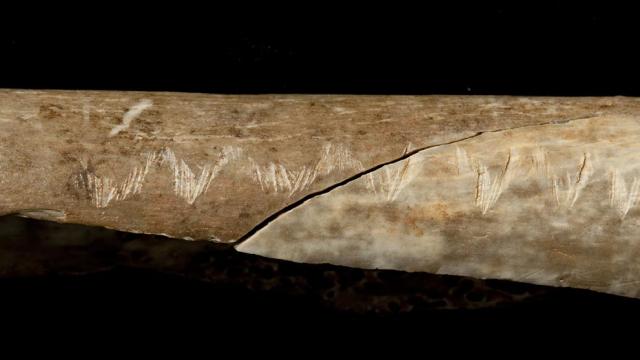Distinctive zig-zag etchings on a prehistoric human bone found at Gough’s Cave in England suggests that Ice Age cannibals consumed human flesh not purely for the nutritional value, but as part of a sophisticated funeral practice.
Etchings on a human forearm. (Image: Natural History Museum)
Scientists studying the 15,000-year-old human remains found at Gough’s Cave in Somerset, England, have already show that Ice Age Britons consumed human flesh, but they weren’t sure if these ancient cannibalistic practices had ritualistic significance. An analysis of a human forearm unearthed at the site suggests that the patterned engravings on the bone were a deliberate component of the cannibalistic practice — one likely rich in symbolic meaning.
The British Natural History Museum researchers who wrote the study, now published in PLoS One, believe the zig-zag pattern was not the result of the butchering process, nor the result of teeth marks on the bone (human or otherwise). The researchers, led by Silvia M. Bello, say the forearm was filleted (removed from the body), defleshed, and then marked with the etchings. Afterward, the bone was broken-up to extract the nutritious marrow.

Image: S. M. Bello et al., 2017/PLoS One
Interestingly, there’s no evidence to suggest that these cannibalised humans were the victims of violence — it seems more likely that they died of natural causes. The researchers can’t be entirely certain as to the intent of ancient cannibals, but other research suggests they weren’t simply eating humans as a matter of survival; cannibalism wasn’t worth the trouble given the alternatives.
Bello’s team studied each mark under a microscope, looking at depth and the angles of incision. They were able to distinguish marks made for butchery, those made by teeth, and those made for the engravings. The patterned etchings appear to have been made in one sitting, by a single individual using one tool. Cracks appear directly through the engravings, which suggests the marks were made before these humans extracted the marrow.
“The sequence of the manipulations suggests that the engraving was a purposeful component of the cannibalistic practice, implying a complex ritualistic funerary behaviour that has never before been recognised for the Palaeolithic period,” write the authors in the study. “We can only speculate about the context in which this happened.”
The researchers suggest cannibal engravings may have been a way to remember events, places or circumstances — a sort of written memory or symbolic glue that bound complex social groups together. This particular engraving may have been a “story-tale” directly related to the deceased, perhaps something indicative of the person, important events from their life, the way they died, or even the cannibalistic ritual itself.
“In my opinion, this is an excellent study that shows how there is potential for acts of Palaeolithic cannibalism to have ritual elements that may extend to the consumption of the human body, and not just a ritual focus on the skulls — which we knew from previous work by the author team on the Gough’s Cave assemblage,” said James Cole, an archaeologist at the University of Brighton who wasn’t involved in the study, in an interview with Gizmodo. “I think the study shows that acts of cannibalism can be incredibly socially complex even though we may never know the motivations behind why these humans were eaten.”
Truly fascinating stuff — a finding that’s resetting our notions of what it meant to be a cannibal in ancient times.
[PLoS One]
